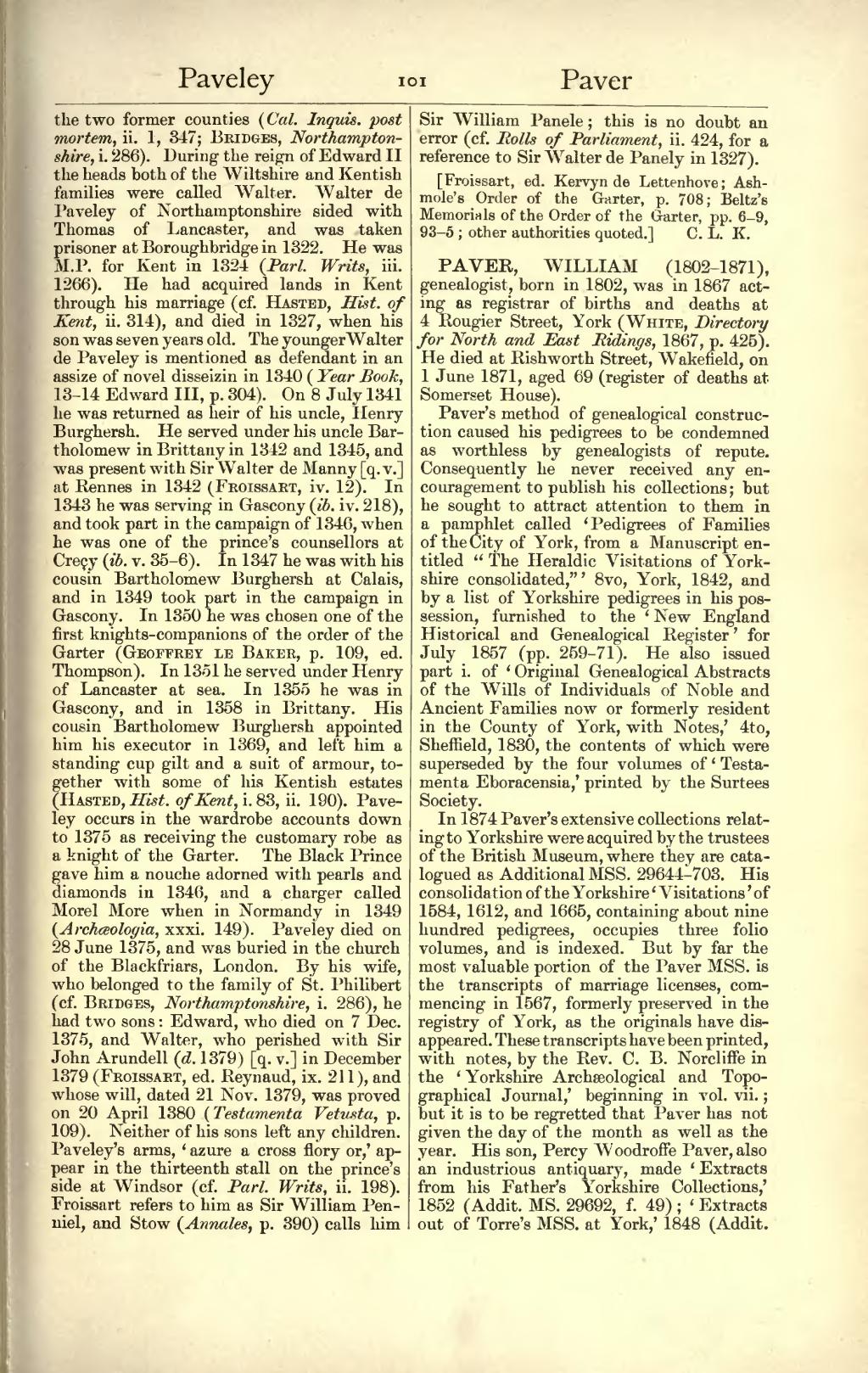the two former counties (Cal. Inquis. post mortem, ii. 1, 347; Bridges, Northamptonshire, i. 286). During the reign of Edward II the heads both of the Wiltshire and Kentish families were called Walter. Walter de Paveley of Northamptonshire sided with Thomas of Lancaster, and was taken prisoner at Boroughbridge in 1322. He was M.P. for Kent in 1324 (Parl. Writs, iii. 1266). He had acquired lands in Kent through his marriage (cf. Hasted, Hist. of Kent, ii. 314), and died in 1327, when his son was seven years old. The younger Walter de Paveley is mentioned as defendant in an assize of novel disseizin in 1340 (Year Book, 13–14 Edward III, p. 304). On 8 July 1341 he was returned as heir of his uncle, Henry Burghersh. He served under his uncle Bartholomew in Brittany in 1342 and 1345, and was present with Sir Walter de Manny [q. v.] at Rennes in 1342 (Froissart, iv. 12). In 1343 he was serving in Gascony (ib. iv. 218), and took part in the campaign of 1346, when he was one of the prince's counsellors at Crecy (ib. v. 35–6). In 1347 he was with his cousin Bartholomew Burghersh at Calais, and in 1349 took part in the campaign in Gascony. In 1350 he was chosen one of the first knights-companions of the order of the Garter (Geoffrey le Baker, p. 109, ed. Thompson). In 1351 he served under Henry of Lancaster at sea. In 1355 he was in Gascony, and in 1358 in Brittany. His cousin Bartholomew Burghersh appointed him his executor in 1369, and left him a standing cup gilt and a suit of armour, together with some of his Kentish estates (Hasted, Hist. of Kent, i. 83, ii. 190). Paveley occurs in the wardrobe accounts down to 1375 as receiving the customary robe as a knight of the Garter. The Black Prince gave him a nouche adorned with pearls and diamonds in 1346, and a charger called Morel More when in Normandy in 1349 (Archæologia, xxxi. 149). Paveley died on 28 June 1375, and was buried in the church of the Blackfriars, London. By his wife, who belonged to the family of St. Philibert (cf. Bridges, Northamptonshire, i. 286), he had two sons: Edward, who died on 7 Dec. 1375, and Walter, who perished with Sir John Arundell (d. 1379) [q. v.] in December 1379 (Froissart, ed. Reynaud, ix. 211), and whose will, dated 21 Nov. 1379, was proved on 20 April 1380 (Testamenta Vetusta, p. 109). Neither of his sons left any children. Paveley's arms, ‘azure a cross flory or,’ appear in the thirteenth stall on the prince's side at Windsor (cf. Parl. Writs, ii. 198). Froissart refers to him as Sir William Penniel, and Stow (Annales, p. 390) calls him Sir William Panele; this is no doubt an error (cf. Rolls of Parliament, ii. 424, for a reference to Sir Walter de Panely in 1327).
[Froissart, ed. Kervyn de Lettenhove; Ashmole's Order of the Garter, p. 708; Beltz's Memorials of the Order of the Garter, pp. 6–9, 93–5; other authorities quoted.]
PAVER, WILLIAM (1802–1871), genealogist, born in 1802, was in 1867 acting as registrar of births and deaths at 4 Rougier Street, York (White, Directory for North and East Ridings, 1867, p. 425). He died at Rishworth Street, Wakefield, on 1 June 1871, aged 69 (register of deaths at Somerset House).
Paver's method of genealogical construction caused his pedigrees to be condemned as worthless by genealogists of repute. Consequently he never received any encouragement to publish his collections; but he sought to attract attention to them in a pamphlet called ‘Pedigrees of Families of the City of York, from a Manuscript entitled “The Heraldic Visitations of Yorkshire consolidated,”’ 8vo, York, 1842, and by a list of Yorkshire pedigrees in his possession, furnished to the ‘New England Historical and Genealogical Register’ for July 1857 (pp. 259–71). He also issued part i. of ‘Original Genealogical Abstracts of the Wills of Individuals of Noble and Ancient Families now or formerly resident in the County of York, with Notes,’ 4to, Sheffield, 1830, the contents of which were superseded by the four volumes of ‘Testamenta Eboracensia,’ printed by the Surtees Society.
In 1874 Paver's extensive collections relating to Yorkshire were acquired by the trustees of the British Museum, where they are catalogued as Additional MSS. 29644–703. His consolidation of the Yorkshire ‘Visitations’ of 1584, 1612, and 1665, containing about nine hundred pedigrees, occupies three folio volumes, and is indexed. But by far the most valuable portion of the Paver MSS. is the transcripts of marriage licenses, commencing in 1567, formerly preserved in the registry of York, as the originals have disappeared. These transcripts have been printed, with notes, by the Rev. C. B. Norcliffe in the ‘Yorkshire Archæological and Topographical Journal,’ beginning in vol. vii.; but it is to be regretted that Paver has not given the day of the month as well as the year. His son, Percy Woodroffe Paver, also an industrious antiquary, made ‘Extracts from his Father's Yorkshire Collections,’ 1852 (Addit. MS. 29692, f. 49); ‘Extracts out of Torre's MSS. at York,’ 1848 (Addit.
